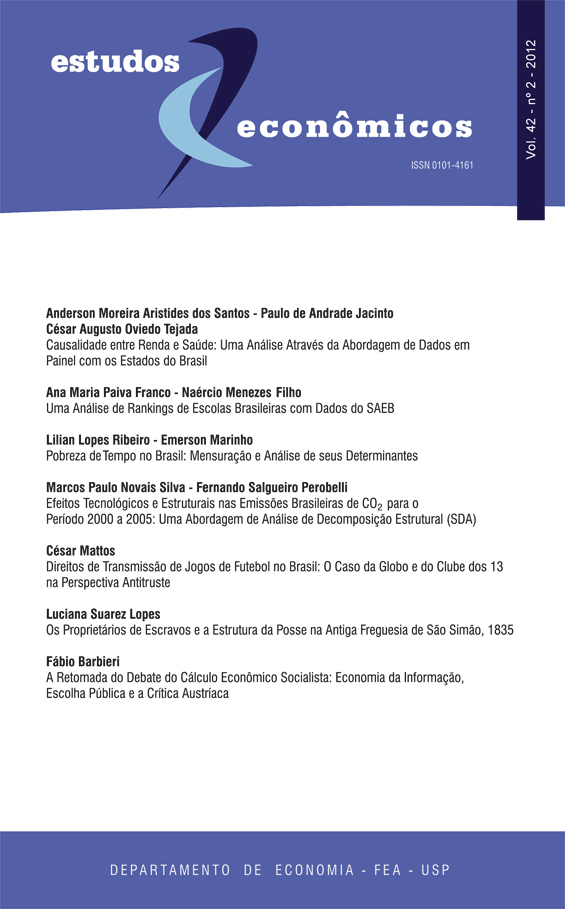Time poverty in Brazil: measurement and analysis of its determinants
DOI:
https://doi.org/10.1590/S0101-41612012000200003Palavras-chave:
Pobreza de tempo, Bem-estar, Alocação de tempoResumo
Este artigo analisa, a nível individual, o bem-estar, através da alocação de horas trabalhadas de adultos e crianças, mensurando-se a pobreza de tempo para o Brasil. Neste sentido, indicadores de pobreza de renda da classe Foster, Greer e Thorbecke (FGT) são adaptados para medir a pobreza de tempo. Além disso, uma análise dos seus determinantes também é realizada. Entre outros resultados do artigo, as mulheres (crianças ou adultas) são mais pobres de tempo, seja na área urbana ou rural. Outro resultado preocupante é a alta proporção de pobreza de tempo das crianças na ordem de 16,1%, não muito distante da população adulta que é de 19,7%. O perfil de pobre de tempo é de mulher adulta, de cor negra e com baixa escolaridade, não necessariamente pobre de renda, e residente na área urbana da região nordeste, morando em domicílio com poucas pessoas e mãe de filhos com menos de 14 anos de idade.
Downloads
Referências
Apps, P. Gender, Time Use, and Models of the Household. Washington, D. C: World Bank, 2004. (Policy Research Working Paper Series: 3233).
Bardasi, E.; Wodon, Q. Measuring Time Poverty and Analyzing Its Determinants: Concepts and Application to Guinea: Gender, Time Use, and Poverty in Sub-Saharan Africa. Washington, DC: Word Bank, 2006. (World Bank Working Paper, Nº. 73, p. 75-95).
Bardasi, E.; Wodon, Q. Working long hours and having no choice: time poverty in Guinea. Washington, DC: Word Bank, 2009. (Policy Research Working Paper Series 4961).
Blackden, C. M.; Bhanu C. Gender, Growth, and Poverty Reduction. Special Program of Assistance for Africa 1998 Status Report on Poverty. Washington, DC: Word Bank, 1999. (Paper Nº. 428).
Burchardt, T. Time an income poverty. CASE Report 57, London. 2008. (Centre for Analysis of Social Exclusion, London School of Economics).
Damián, A. La pobreza de tiempo. Uma revisión metodológica, Estudios Demográficos y urbanos. v. 18, nº. 52, p.127-162. 2003.
Dedecca, C. Tempo, trabalho e gênero. Reconfiguração das relações de gênero no trabalho. CUT - Central Única dos Trabalhadores. São Paulo, 2004. http://library.fes.de/pdf-files. Accessed in 07 de august de 2011.
Douthitt, R. A. Time to do the Chores? Factoring Home-Production Needs into Measures of Poverty. Vol. 21 nº 1, 7-22. Journal of family and economic issues, 1994.
Foster, J.; Greer, J.; Thorbecke, E. A Class of Decomposable Poverty Indices, Econometrica. v.52, n.3, p.761-766.1984.
Gelb, A. Gender and Growth: Africa’s Missed Potential. Washington, DC: World Bank, 2001. (Paper No. 197).
Harvey, A. S.; Taylor, M. 1996. An LSMS Time-use Module Department of Economics, St. Mary’s University, mimeograph.
Ilahi, N. Gender and the Allocation of Adult Time: Evidence from the Peru LSMS Panel Data, Policy Research Working Paper Series No. 2744, World Bank, 2001.
Ilahi, N. The Intra-household Allocation of Time and Tasks: What Have We Learnt from the Empirical Literature? Policy Research Report on Gender and Development, Working Paper Series Nº. 13, Washington, DC: World Bank Development Research Group, 2000.
Instituto Brasileiro de Geografia e Estatística (IBGE). Pesquisa Nacional por Amostra em Domicílio – PNAD 2009. Rio de Janeiro: IBGE, 2009.
Instituto de Epilepsia e Sono (IES). O sono de uma criança. Goiânia, 2011.
Kalenkoski, C. M.; Hamrick, K; Andrews, M. Time Poverty Thresholds. Ohio University, 2008. (Economic Research Service Nº. 58-4000-6-0120).
Kes, A.; Swaminathan, H. Gender and time poverty in sub-Saharan Africa. Washington DC: Word Bank, 2006. (Paper Nº. 73. World Bank).
Lawson, D. A. Gendered Analysis of Time Poverty: The Importance of Infrastructure. Department of Economics. Manor Road, Oxford, Reino Unido, 2007. Available in: <http://www.economics.ox.ac.uk/ accessed in 03 de November de 2010.
Long, J.; Freze, J. Regression models for categorical dependent variables using Stata. College Station: Stata. Press, 2001.
Newman, C. Gender, Time Use, and Change: The Impact of the Cut Flower Industry in Ecuador. World Bank Economic Review. v. 16, p. 375-95. 2002.
Schwartzman, S. O trabalho infantil no Brasil. Instituto de Estudos do Trabalho e Sociedade, UFRJ. Rio de Janeiro, 2004. Available in: http://www.schwartzman.org.br. Accessed in 07 de august de 2011.
Sen, A. Development as Freedom. Oxford: Oxford University Press, 1999.
Vickery, C. The Time-Poor: A New Look at Poverty. Journal of Human Resources. v. 12, nº 01, p.27-48. 1977.
Downloads
Publicado
Edição
Seção
Licença
Copyright (c) 2012 Lilian Lopes Ribeiro, Emerson Marinho

Este trabalho está licenciado sob uma licença Creative Commons Attribution-NonCommercial 4.0 International License.
A submissão de artigo autoriza sua publicação e implica o compromisso de que o mesmo material não esteja sendo submetido a outro periódico.
A revista não paga direitos autorais aos autores dos artigos publicados.





 Atualizado em 14/08/2025
Atualizado em 14/08/2025